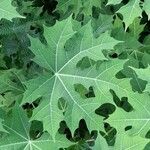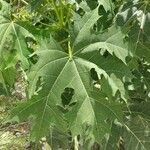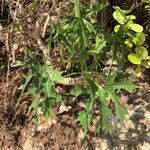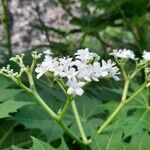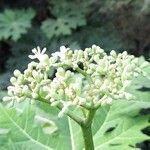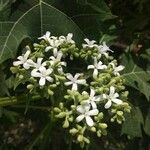Tree or arborescent shrub ca 3-8 m high; glabrous, stinging hairs sparse or absent except on petioles and leaf veins. Leaves thinly chartaceous; petioles ca 15-25 cm long, usually unarmed or nearly so; junction of petiole and blade with a single median dark reniform gland ca 2-3 mm wide; stipules very inconspicuous; blades as broad as or broader than long, usually 15-25 cm across and deeply cut, with 5 main lobes and 2 smaller basal lobes, the lobes oblong to obovate, often ? runcinate-pinnatifid, sharply toothed, acuminate. Dichasia terminal; peduncles ca 15-30 cm long, smooth or sometimes armed, the first branches opposite, the forks of dichasium compact, the inflorescence 3-6 cm across at anthesis, the axes of inflorescence densely and closely minutely pilose. Staminate flowers subsessile; perianth greenish-white, minutely pilose outside but usually unarmed, ca 10-14 mm long, the perianth tube distally dilated, 6-10 mm long, lobes roundish-oblong, 4-6 mm long; disc ca 1-1.5 mm across; stamens with filaments united for most of their lengths into a column, the outer ones 4-5 mm long, the inner 8-9(-12) mm long, the anthers ca 1.5 mm long; staminodes 3, 4-5 mm long. Pistillate flowers subsessile or on short pedicels 1-2 mm long; calyx-segments whitish, linear-oblong, deciduous, 5-7 mm long; disc similar to that of staminate flower; ovary pubescent, the styles 3-4 mm long, connate for 1 mm at base, 3-4-fid into narrow segments. Capsules unarmed, green, minutely rugose, 8-12 mm long; seeds elliptic, com-pressed, 6-8.5 mm long, 4-5.5 mm broad, pale to dark brown and mottled, the caruncle deltoid-cordate, 1.5-2 mm high, 2-2.8 mm broad.
More
A shrub. It can grow 2 m tall. It can be a tree up to 7 m tall. It is a small densely shady, rounded tree. The central stem is about 10 cm across. The side branches are 2 cm thick and end abruptly. The cut stem exudes latex. Some varieties have stinging hairs on the leaves. The domesticated varieties need to be chosen. The leaves are large and dark green. They have deep lobes arranged like fingers on a hand. There are coarse teeth around the edge. The leaves can be 22 cm wide and 18 cm long. The leaves are not flat. The leaf stalks are 60 cm long. The flowers are small. The flowering stalks have 3-4 forks. The whole flower head is 2-10 cm across. The female flowers are near the lowest forks and the male flowers at the ends. The flowers have an unpleasant smell. Some varieties occur. The forms without stinging hairs are classified as Chayamansa group.
The leaves are boiled and eaten as a vegetable. Gloves are used in harvesting to avoid stinging hairs. The leaves are chopped and then boiled for about 20 minutes. They can be used in soups and stews. CAUTION: The leaves contain a toxin which is removed by boiling. This hydrocyanic acid is removed by boiling for at least 2 minutes.
Plants are grown from cuttings. Thick cuttings can be slow to root and thin cuttings can rot. It is best to allow the cutting to dry for a day or two before planting to avoid rotting. They can be planted at any time of the year. Cuttings from 10 cm to 1 m can be used. They can be planted directly into well drained soil that is not too wet. The plants can be used as a hedge.
